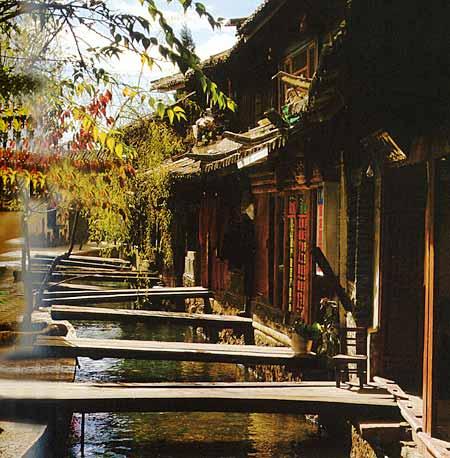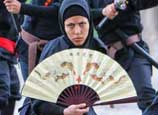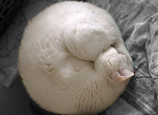
 |
| The Old Town of Lijiang (CNTV) |
The water systems in the Old Town of Lijiang are usually small in size. According to their external forms, they can be divided into three types: branch water system, flat surface water system and dot water system. The branch water system means the network of Jade River. The Jade River originates from the Black Dragon Pool, and when it reaches the Jade Dragon Bridge in the north of the Town, it is divided into three branches: Eastern River, Middle River and Western River. Then, the three branches are divided into many even smaller branches, forming a branch-shaped water system. The flat surface system includes the Black Dragon Pool and White-Horse Dragon Pool. The former one is at the foot of the Elephant Mountain, to north of the county seat, where the spring water sprays out from the cracks of the mountain and joins together so that this pool forms. This pool is the source of the Jade River and can regulate the flow of the water system of Jade River. The latter pool is at the southern foot of the Jade Lion Mountain and also called the “Lion Milk Spring.” The dot water system means wells and small pounds. The most typical form of this system is the “three-eye well.” The water in the upper eye is for drinking, in the middle for washing vegetable, and in the lower for washing clothes. In the Old Town of Lijiang, the main street is on the riverside and many small alleyways are also close to water channels. Over 300 old stone bridges harmoniously coexist with the river water, green trees, ancient alleyways and old house, making this plateau water town a place with high value in aesthetics.
The bridges are the structural joints that connect the water systems and street systems of the Old Town of Lijiang. As one of the oldest architectural types of the town, they link all the ground and water surfaces of the town. On the water system of the Jade River, there are 354 bridges. This means 93 bridges per square kilometer in average. The shapes of the bridges are various, and the renowned bridges include the Suocui Bridge, Big Stone Bridge, Wanqian Bridge, South Gate Bridge, Horse Saddle Bridge and Renshou Bridge, all of which were built in the Ming and Qing dynasties (14th century to 19 century A. D.). Of them, the most distinctive is the Big Stone Bridge which is located 100 meters to the east of the Sifang Street. The ancient bridges are not only important transportation facilities but also markets and places where people communicate in the Old Town. They have abundant cultural content.
Another special characteristic of the Old Town of Lijiang is its unique-style folk houses, which absorbed and digested the excellent architectural traditions of the Central Plains and the Bai and Tibetan nationalities, and made bold innovations in many aspects such as overall design and construction skills. The common form of the folk houses is the courtyard house, which usually include three major rooms, a courtyard, a central hall, two side rooms and an individual gate tower. Based on this common form, many more complicated folk house forms of various plain layouts have also been generated, such as the “Two-House Corner,” “Three Houses with One Screen Wall,” “Four-House Five-Yard Quad,” “Double Front-Back Courtyard,” “Double Courtyard with One Gate” and “Combination of Courtyards.” Of them, the “Four-House Five-Yard Quad” form is a traditional cultural heritage of the Naxi nationality. Of this form, the four houses on the four sides surround the central yard, and there are four small individual yards on the four connecting places of the four houses. The big yard in the center is the public place for the families to hold various activities. The four small yards are supplementary spaces for ventilation and getting sunshine. If it is possible, the people of Lijiang would draw water into their courtyards, or let water flow around their houses, or build their houses on the waterside, making their folk houses have both the northern “quad” features and the southern water town features. In terms of external styling and structural design, the folk houses of Lijiang absorbed the architectural skills of the Central Plains and Tibetan and Bai nationalities, and many unique local architectural skills, such as the distinctive mud-stone walls, unique-style roofs, small blue tile and wooden structure, have already formed.


















 Wild Siberian tiger kills cattle in NE China
Wild Siberian tiger kills cattle in NE China


![]()
